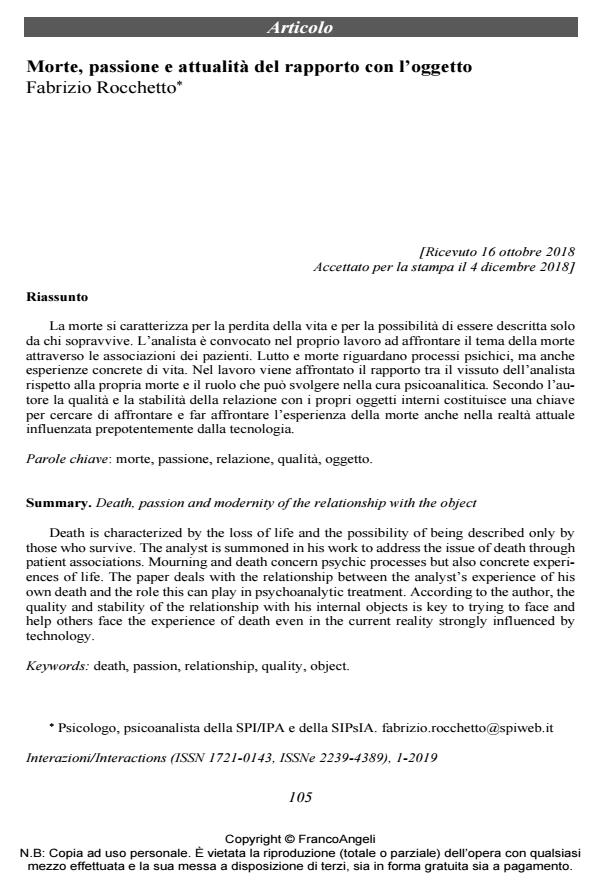Morte, passione e attualità del rapporto con l’oggetto
Titolo Rivista INTERAZIONI
Autori/Curatori Fabrizio Rocchetto
Anno di pubblicazione 2019 Fascicolo 2019/1
Lingua Italiano Numero pagine 14 P. 105-118 Dimensione file 167 KB
DOI 10.3280/INT2019-001008
Il DOI è il codice a barre della proprietà intellettuale: per saperne di più
clicca qui
Qui sotto puoi vedere in anteprima la prima pagina di questo articolo.
Se questo articolo ti interessa, lo puoi acquistare (e scaricare in formato pdf) seguendo le facili indicazioni per acquistare il download credit. Acquista Download Credits per scaricare questo Articolo in formato PDF

FrancoAngeli è membro della Publishers International Linking Association, Inc (PILA)associazione indipendente e non profit per facilitare (attraverso i servizi tecnologici implementati da CrossRef.org) l’accesso degli studiosi ai contenuti digitali nelle pubblicazioni professionali e scientifiche
La morte si caratterizza per la perdita della vita e per la possibilità di essere descritta solo da chi sopravvive. L’analista è convocato nel proprio lavoro ad affrontare il tema della morte attraverso le associazioni dei pazienti. Lutto e morte riguardano processi psichici, ma anche esperienze concrete di vita. Nel lavoro viene affrontato il rapporto tra il vissuto dell’analista rispetto alla propria morte e il ruolo che può svolgere nella cura psicoanalitica. Secondo l’autore la qualità e la stabilità della relazione con i propri oggetti interni costituisce una chiave per cercare di affrontare e far affrontare l’esperienza della morte anche nella realtà attuale influenzata prepotentemente dalla tecnologia.
Parole chiave:Morte, passione, relazione, qualità, oggetto
- Algini M.L. (2016). Le ferite invisibili. Torino: Robin Edizioni.
- Baldassarro A. (2018). La passione del negativo. Milano: FrancoAngeli.
- Bach S. (2008). On digital consciousness and psychic death. Psychoanalytic Dialogues, 18, 6: 784-794. DOI: 10.1080/10481880802473290
- Balsamo M. (2017). Trasformazioni identitarie. Rivista di Psicoanalisi, 2: 437-445.
- Bernstein A. (1987). Love and Death: Lettin go. Modern Psychoanalysis, 12, 2: 195-206.
- Bordi S. (2002). Prefazione. In De Masi F. (2002). Il limite dell’esistenza. Torino: Boringhieri.
- Cancrini T. (2002). Un tempo per il dolore. Torino: Boringhieri.
- Canetti E. (2014). Il libro contro la morte. Milano: Biblioteca Adelphi, 2017.
- Centro Psicoanalitico di Roma (2010). Intendere la vita e la morte. Milano: FrancoAngeli.
- Crary J. (2013). 24/7. Il capitalismo all’attacco del sonno. Torino: Einaudi, 2015.
- De Masi F. (2002). Il limite dell’esistenza. Torino: Boringhieri.
- Fachinelli E. (2012). Su Freud. Milano: Adelphi.
- Ferraro F., Garella A. (2001). In-fine. Milano: FrancoAngeli.
- Foresti G. (2017). L’identità psicoanalitica: cinque ipotesi per un dibattito. Rivista di Psicoanalisi, 2: 381-401.
- Freud S. (1915a). Considerazioni attuali sulla vita e sulla morte. OSF, vol. 8. Torino: Bollati Boringhieri.
- Freud S. (1915b). Caducità. OSF, vol. 8. Torino: Bollati Boringhieri, 1976.
- Freud S. (1917). Lutto e melanconia. OSF, vol. 8. Torino: Bollati Boringhieri, 1976.
- Jaques E. (1970). Morte e crisi di mezza età. In Jaques E., Kernberg O., Thompson C., L’età di mezzo. Milano: Bollati Boringhieri, 1993.
- Lachmann F.M. (1985). On transience and the Sense of Temporal Continuity. Contemporary Psychoanalysis, 21: 193-200. DOI: 10.1080/00107530.1985.1074577
- Laufer E. (1987). Suicide in adolescence. Psychoanalytic Psychotherapy, 3, 1: 1-10.
- Laufer M. (1995). Comprendere il suicidio: assume un particolare significato in adolescenza? In Laufer M., L’adolescente suicida. Roma: Borla, 1997.
- Leavy S. (2011). The last of life: psychological reflections on old age and death. Psychoan. Quarterly, LXXX, 3: 699-715.
- Lombardi R. (2013). Death, time and psychosis. Journal of the American Psychoanalytic Association, 61, 4: 691-726.
- Lussana P. (2012). Stai per morire. Rivista di Psicoanalisi, LVIII, 1: 183-184.
- Marzi A. (2013). Psicoanalisi, identità e internet. Milano: FrancoAngeli.
- Masina L. (2018). La passione dell’analista. Rivista di Psicoanalisi, LXVI, 1: 13-31.
- Monniello G. (2011). Le gravidanze delle adolescenti. AeP, 2: 9-11.
- Nicolò A.M. (2010). La relazione paradossale tra due aspetti della passione: tra creatività e distruzione. Lavoro presentato al Convegno della FEP, Londra, 2010.
- Nicolò A.M. (2013). Percorsi della nuova genitorialità. Lavoro presentato al Centro di Psicoanalisi Romano il 9 novembre 2012.
- Razinsky L. (2011). Against Death’s Representability: Freud and the Question of Death’s Psychic Presence. Psychoanalytic Study of the Child, 65: 332-357. DOI: 10.1080/00797308.2011.11800844
- Reeves C. (1996). Transition and transience: Winnicott on leaving and dying. Journal Child Psychotherapy, 22, 3: 444-455. DOI: 10.1080/00754179608254518
- Rocchetto F. (2014). Diventare soggetti ed Erosione dello spazio potenziale. Atti del Congresso della Società Psicoanalitica Italiana, Milano, 22-25 maggio 2014.
- Russo L. (1998). L’indifferenza dell’anima. Roma: Borla.
- Russo L. (2017). L’identità analitica dell’analista e i suoi paradossi. Rivista di Psicoanalisi, 2: 367-379.
- Sandler J. (1983). Reflections on some relations between psychoanalytic concepts an psychoanalytic pratice. The International Journal of Psycho-Analysis, 64: 35-45.
- Sapio M. (2011). Concepire e abortire tra fantasia e realtà. AeP, 2: 25-42.
- Schubert J. (2001). Between eternity and transience. The Scandinavian Psychoanalytic Review, 24: 93-100. DOI: 10.1080/01062301.2001.1059262
- Semi A.A. (2018). Il metodo come scoperta e la scoperta come metodo. Lavoro presentato al Centro di Psicoanalisi Romano il 21 settembre 2018.
- Souter K.M. (2009). The war memoirs: some origins of the thought of W. R. Bion. The International Journal of Psychoanalysis, 90, 4: 795-808.
- Yamamoto T. (2009). Hagakure. Il libro segreto dei Samurai. Milano: Oscar Mondadori.
- Winnicott C. (1997). Donald Winnicott come persona. In Bonaminio V., Giannakoulas A. (a cura di), Il pensiero di D.W. Winnicott. Roma: Armando, 2007.
- Winnicott D.W. (1947). L’odio nel controtransfert. In Winnicott D.W. (1958), Dalla pediatria alla psicoanalisi. Firenze: Martinelli, 1975.
- Winnicott D.W. (1971). Oggetti transizionali e fenomeni transizionali. In Winnicott D.W. (1971), Gioco e realtà. Roma: Armando, 1974.
- Ziccardi G. (2017). Il libro digitale dei morti: Memoria, lutto, eternità e oblio nell’era dei social network. Milano: UTET.
Fabrizio Rocchetto, Morte, passione e attualità del rapporto con l’oggetto in "INTERAZIONI" 1/2019, pp 105-118, DOI: 10.3280/INT2019-001008